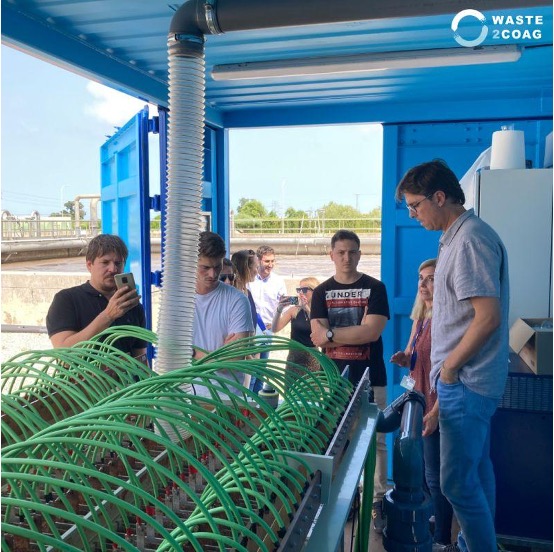The LIFE Waste2Coag project co-funded by the EU LIFE programme (LIFE20 ENV/ES/000430) has recently entered its 3rd year and is making great strides in its transformation of the wastewater treatment process.
The LIFE Waste2Coag project started in October 2021 and aims to demonstrate an innovative and cost-effective technology to produce coagulants for the removal of pollutants in wastewater, including emerging pollutants and pathogens. The proposed technology is based on an electrolysis process to valorise brines and industrial metal scrap wastes to produce coagulants. This new technology will avoid unsustainable disposal methods and work in line with circular economy concepts. Additionally, the LIFE Waste2Coag technology can be considered as a zero-waste technology as it does not generate any unwanted stream or by-products, making it an efficient and sustainable solution.
Why is the LIFE Waste2Coag project important?
The current world population is 7.8 billion and is expected to rise to at least 9.8 billion in 2050; with these rising numbers the pressure on natural resources and specifically water scarcity problems will increase in the future. Population growth also leads to an increase in the demand for raw materials, yet, due to an increase in metal demands, there is also a scarcity of resources. It is estimated that metals represent 3% of the total solid wastes generated in the EU, whereas only around 3% of the raw materials necessary to meet increasing metal demands are produced.
The LIFE Waste2Coag project aims to boost the implementation of circular economy principles in water treatment plants by creating synergies with other industrial sectors by valorising industrial scrap metallic wastes and brines generated in different industries, including wastewater treatment plants (WWTP) and desalination plants (DP).
Within the project an innovative technology, called the Electrolytic System (ELS), is being developed and tested. This technology aims to produce coagulants by the direct recovery of brines and metal scraps, providing the option to use raw materials for water treatment instead of using the conventional primary sources of non-renewable origin. After the project’s completion the LIFE Waste2Coag team will propose the inclusion of this technology as a Best Available Technique (BAT) in the BAT Reference Documents (BREF). The BREF are the main reference documents used by competent authorities in EU countries when issuing operating permits for industrial installations that represent a significant pollution potential.
The ELS

AIDIMME Technology Institute (AIDIMME) is a technological partner responsible for the design and optimisation of the ELS. Together with Global Omnium (GOMSL), the coordinator of the project who built the prototype, they have installed it at the WWTP in Gandia (Spain). After validating the technology at the first site, the ELS will be tested in two more demo sites, an urban WWTP in Wulpen (Belgium) and an industrial WWTP at Joviar’s facility in Ibi (Spain).
Additionally, Aquafin NV (AQUAFIN) have made primary preparations to ensure readiness for the reception of the ELS for the 2nd pilot installation at the Wulpen WWTP and hope to successfully ensure its efficient operational start-up within 2024. Also, AIDIMME aims to complete the optimisation of operating parameters and brine selection routes for processing with the ELS. The application of work parameters in urban WWTPs is also expected to take place this year.
The characterisation of brines in LIFE Waste2Coag
Further progress involved in the LIFE Waste2Coag surrounds the action of brine characterisation. Creaciones Joviar (JOVIAR) have characterised the brines from their demineralisation equipment and are continuing to carry out periodic monitoring through basic parameters for the operation of the ELS . Together with AIDIMME, JOVIAR have characterised the different streams of the regeneration stages of their demineralisation equipment, identifying which batches will be appropriate for feeding the ELS. JOVIAR is thrilled with the progress that has been made in the project so far, as well as the collaboration between the consortium.
“The project has provided us with better knowledge of the waste we produce and which we can surely value internally, reducing costs in the company. Regarding the consortium, the experience is being very positive due to the proximity and commitment of all the partners.”
JOVIAR – Project Partner
Together AIDIMME and GOMSL have processed 4 types of brines from different industries, in doing this the project partners have further determined the critical parameters in these brines that could potentially affect their treatment, therefore, during the processing of these brines, reasons for discard and selection were also identified. During the next six months GOMSL will work on the evaluation of the produced coagulants and their application in the urban WWTP in Wulpen.
The overall progress of the LIFE Waste2Coag assures all consortium members that the project will succeed in meeting its original objectives and the ELS technology will have a positive environmental, societal, and economic impact across the globe.
To follow the LIFE Waste2Coag journey, follow us on LinkedIn and Twitter.
